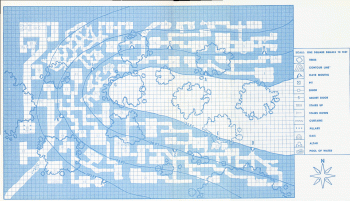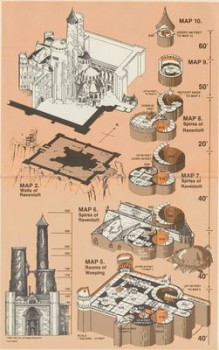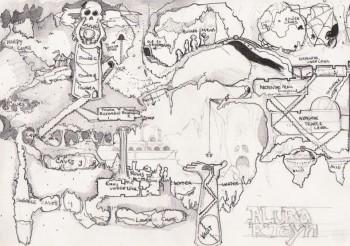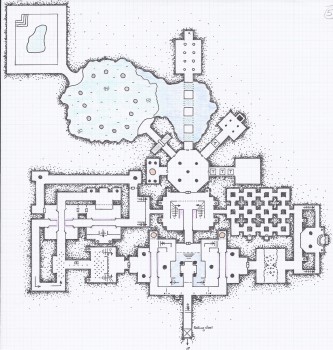Art of the Genre: Art of Dungeon Maps

“Which one do you like?” I asked, knowing full well what his answer would be.
“This one,” he replied, pointing to the top shelf where Easley’s red dragon fighting with four pegasi on the cover of Monster Manual stood at attention.
Yep, of course my son the vegetarian and animal activist would pick that one, even if the animals involved are all imaginary.
A conversation followed with various questions like, “That man is going to save his friend, right?” for the cover of Wilderness Survival Guide, and, “I know the ninja is going to get away.” for the cover of Oriental Adventures.
As he slid his fingers along the covers, pointing out other details, my copy of Dungeoneer’s Survival Guide toppled to the floor. He turned to look at me, nervous, and I smiled and told him to bring the book over and I’d show him something cool inside.

I noticed two things immediately when I started flipping through the pages, the maps were as awesome as I remembered and that Jim Roslof had done the bulk of the interior illustrations which was awesome to see. As I moved through the book I started narrating a tale that plays out in the pages, using both the maps and pictures, we both had a blast before moving on to other things more acceptable to my wife’s sense of what my son should be learning about. [Note: She was none too pleased he now knew the meaning of the word ‘Drow’]
Still, the more I thought of those black and white maps, the more moved I was to go back and find some of my favorites. You see, there is something innately D&D about 10 x10 squares laid out in a pattern on graph paper. I mean, it is DUNGEONS & Dragons after all.
I’ll contend that along with polyhedral dice, there is little to nothing that can get a true gamer excited like the twisting labyrinth of a well made dungeon. It might be yet another reason [the first one being the accumulation of gold and magic] science fiction role-playing isn’t as popular as fantasy. Flying in space doesn’t give you the same concrete appeal as a DM saying, ‘The stone passage opens around you with a door on your left, twenty feet down a door on your right, or the passage continues into darkness beyond that.’
During my time in the industry I’ve heard various stories concerning maps and their creation, most being that artists hated doing them or having them assigned to them when there was ‘real’ art to be done. I’m not sure this was always the case, but I can say that for particularly ‘old school’ gamers the designs of David ‘Diesel’ LaForce and Steve Sullivan are just as integral and important to the game, and probably more so, as any cover painting by Elmore or Easley.

I mean seriously, who can forget The Caves of Chaos from B2 Keep on the Borderlands? That is a classic blue and white dungeon that is begging to be delved. Anyone remember the Forbidden City map from I1 Dwellers of the Forbidden City? How about Kordan’s Master Maze in I3 Pharaoh? Then there’s G1 and the famed Steading of the Hill Giant Chief or the Sahuagin’s Lair in U3 The Final Enemy? And if you like 3D maps, how about Straad’s Castle in I6 Ravenloft?
Truly, the list above could go on and on, but I have only a limited number of words to use here so I’ll just let the others ruminate in my nostalgic memory. The above aren’t the only type of maps that I recall, either, how about some of those old school dungeon crawl games like Wizardry or Bard’s Tale? I have no idea how many hours I tried to use my meager mapping skills on the dungeons of those games but I never seemed to get them just right.
Those computer dungeons might have been the oddity in the 80s, but in today’s RPG landscape pretty much everything we see coming out of the industry is computer generated. Once again, digital seems to make everyone’s job easier, but I contend that the passion of a map is still better seen if drawn by the human hand. To give some resonance to this claim, I’m going to show you a few examples of old school style thats still being employed today.

My venerable DM Mark is also a wonderful mapper, and I’ve had the pleasure of taking on many of his more detailed dungeons over the years. Even after all the death, victory, experience, and treasure involved in the adventures around them, I often think my favorite part is having him hand the dungeon over to me afterward so I can actually see what I’ve accomplished in glorious hexes of black and white.
This then is a defining moment for the art of gaming maps, that not only can you be captured by their architectural nature, but when you’ve played through them, they forever become a part of you. In a way, it’s like becoming a part of a picture, much more so than a cover painting of a book you’ve read.
The true ‘art’ of any Art is when it captures its target audience, and dungeon maps do exactly that even without oil, acrylic, watercolor, or the like. They simply sweep the audience away on grand adventures that allow the participant’s mind to paint them in vivid Technicolor. So today I’m spending a moment with maps, and I hope all of you will as well, because somewhere in those subterranean halls there is a chance for your own grand tale of heroics to begin.
I had the rare and distinct privilege of building levels for a popular Neverwinter Nights persistent world, and by far my favorite part was cutting the level maps in the toolset.
I always did my level best (^-^) to make sure everything lined up AND made sense, so that going through a door(or a cave mouth) or up a stair brought you out where you expected to be.
Because to me, whether indoors or out, nothing broke my immersion more than gross spatial inconsistencies.
Back in the old days, few things frustrated me more than to get a PnP module and find that it had sucky maps in it, although thankfully that was generally the exception and not the rule.
Or even worse, buying a used module (which was mostly what I’d buy) and finding that someone had kept all the maps.
There were even a few modules I bought just for the maps, even though I had no plans of playing them, as they didn’t fit my campaign.
But they were just so cool that I had to have them 🙂
I remember the Ravenloft map blowing me away. For the first time I could truly see what the map represented.
Gruud: Its nice to see that there are others out there who not only like maps, but have made it a point to dedicate their talent to seeing that they are correct. Well done sir! 🙂
Jeff: Yep, Ravenloft was like a whole new world just got opened up…
The maps were the best part of many of the modules/adventures.
I have re-purposed just the maps from several old modules over the years (the dragonlance floating citadel, huma’s tomb, and the high clerist tower, plus MERP’s Angmar and Umbar for example) when either I found the contents to be lacking or the setting to be incompatible with campaign.
As a DM, I never used store-bought dungeons. I regarded them as a sign of shameful lack of imagination, and spent countless hours devising my own. Ultimately the tendency was to have “outdoor” adventures rather than exploring underground dungeons.
TW: You are SO right about Angmar and Umbar, and I’ll also add that pretty much any MERP maps is worth using!
Lugo: A creative man, I like that! 🙂 Did you employ the Wilderness Survival Guide at all in your campaigns?
I just get frissons of nostalgia seeing those old blue-and-white TSR module-cover maps. (The color scheme was to keep them from being photocopied, IIRC.) Now I want to go run a party through B2. Or, more realistically, at least dig it out and reread it.
[…] Black Gate (Scott Taylor) on Art of Dungeon Maps. […]
Joe: Nice catch, I had no idea that TSR printed the maps in blue so they couldn’t be photocopied. And yes, there is little that is better in this world than B2.
I dont remember the blue being much of a deterrent to the old Xerox machine back in the 80s. Sure you might lose some fine lines (like the map grid) but most of it would come through.
Heck I liked the blue because it allowed you to take notes on the map easier…it was perfect for the accumulating mounds of dead parties in the Tomb of Horrors…
I am such a geezer — I started playing eight years before the Wilderness Survival Guide came out. =)
Lugo: Were did you get your wilderness info? Dragon Magazine or did you house rules it, or didn’t it really matter because the adventure wasn’t really about the elements and such?
Mostly house rules. The Player’s Guide and DM’s guide had most of what I needed. And no, it wasn’t really about the elements anyway. The wilderness wouldn’t have time to kill my players before the monsters and nasty NPCs got ’em, heh heh. Also a lot of action happened in urban settings, which was not a wilderness or an underground dungeon but still required extensive mapping on my part.
[…] The Art of Dungeon Maps […]
[…] The Art of the Dungeon Map at Black Gate. “Once again, digital seems to make everyone’s job easier, but I contend that the passion of a map is still better seen if drawn by the human hand. To give some resonance to this claim, I’m going to show you a few examples of old school style that’s still being employed today.” […]
[…] Blackgate.com has an article on the art of the dungeon map with a lot of good resources. http://www.blackgate.com/2012/02/08/art-of-the-genre-art-of-dungeon-maps/ […]